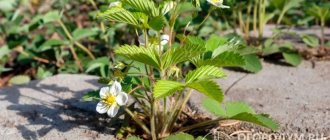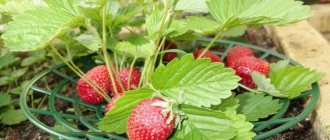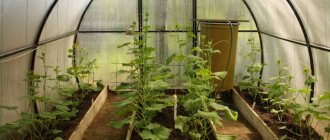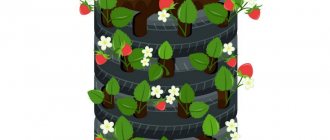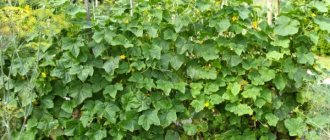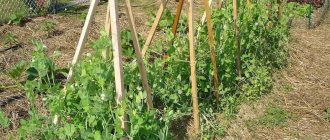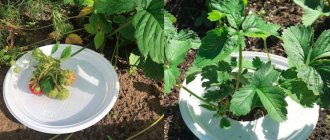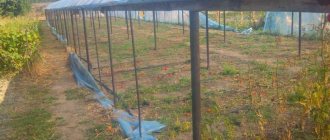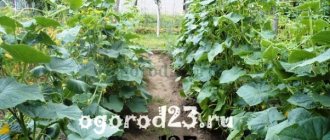Strawberries are a delicacy loved by both adults and children. Many people think that strawberries are very easy to grow: they practically grow on their own. Everything is true if you prepare the beds correctly. There are a huge number of options and first you should study them and choose the most suitable ones according to location and budget.
To arrange beds for strawberries, you should choose a sunny place, away from close groundwater. You should not choose a shady place - strawberries love warmth. And it is important to remember that the sweetest strawberries grow in the sun.
There are two main types of beds: horizontal and vertical beds.
Brief overview of the article
- Horizontal beds
- Low beds
- Raised beds
- Horizontal bed from a barrel
- Horizontal bed made from a tire
- Vertical beds
- Vertical beds made from tires
- The best time to plant strawberries
- Garter of berries
- Saving berries from birds
- Photo of strawberry beds
Horizontal beds
The beds are low and high. These types will be discussed further, the pros and cons of this or that device. It may be common to use dark covering material between strawberry bushes. It is better to use a breathable one, it will not allow the roots to rot and rot.
At the same time, it will give them the necessary warmth and protect them from annoying weeds. It is not very easy to arrange at the very beginning - you need to have patience and make an effort, but the result is worth it. It must be said that the covering material will be suitable for use for more than one season.
Mulching the soil
Mulching strawberry beds is a necessary condition for growing a good harvest of berries. It is necessary to:
- retain moisture in the soil;
- limit weed growth;
- improve the fertile layer;
- make the soil structure more loose and breathable;
- prevent rotting and contamination of ripe berries (they do not come into contact with the ground) even after rain, when the soil is wet.
Even in wet weather, the berries in a mulched garden bed will be clean and will not rot.
The following is used as mulching material:
- straw or grass clippings;
- black agrofibre;
- coniferous litter or branches of coniferous trees;
- shavings and sawdust;
- humus and compost.
Photo gallery: mulching strawberry beds
When straw or mown grass rots, hay bacillus develops, killing fungal infections. Agrofibre protects the soil from drying out and weeds.
Needles increase the acidity of the soil, so use it with caution on acidic soils.
Rotten shavings and sawdust acidify the soil, so you need to periodically add ash or dolomite flour. Humus or compost as mulch requires frequent updating, as it is quickly processed by microorganisms
Low beds
These are the easiest beds to arrange. They do not require any fencing. Their depth is equal to the bayonet of a shovel. The soil is dug up, a fertile layer and fertilizers are added. Abundant watering and you can plant strawberry bushes.
Despite their simplicity, the design of these beds has a drawback - they require regular weeding of the seedlings as they grow and their runners grow. Weeds also need to be pulled out.
And the most important drawback is the likelihood of them being washed away by spring waters, rains and during irrigation. This means it makes sense to make fenced high beds.
The nuances of arranging beds and planting
With proper care, strawberries bear fruit abundantly for five years, after which the bushes age, the soil is depleted and fruiting decreases. Timely renewal of plants and replacement of the top layer of soil will help to avoid this. It is also possible to change the landing zone.
It is important to remember that regardless of the source of origin of the seedlings, careful preventive treatment against diseases is necessary.
It is possible to use both strawberry seedlings purchased in special stores, and to plant your own, obtained by using the properties of the plant to grow a mustache.
To get more runners from each bush, it is recommended to remove flowers and periodically loosen the rows.
For any type of strawberry beds, it is worth considering a number of the following recommendations:
- For each row of plants, it is worth allocating forty centimeters of bed width, in this case, care and harvesting will not cause additional difficulties;
- It is best to place the beds in the direction from east to west, this will provide the best lighting;
- The distance between bushes should not be less than twenty-five centimeters;
- It is not recommended to leave a distance between the beds of less than half a meter, as this will complicate their maintenance;
- For intensive plant development, the height of the beds must exceed twenty centimeters;
- You should not place beds with strawberries under fruit trees, as this can lead to the migration of insect pests to it;
- Planting seedlings under a black film equipped with special holes is considered extremely successful. This will help reduce the likelihood of gray rot and also stop the development of weeds.
When preparing a bed for strawberries, one cannot ignore the organization of the drainage layer and the enrichment of the soil. If the soil is sufficiently fertilized with organic fertilizers before planting, additional fertilizing will not be required for three seasons.
Raised beds
To begin with, the turf is removed from the selected location to the size of the future bed. A box is also made from boards or slate according to the size of the future bed. Then there are at least two options.
In the first option, geotextiles are spread at the bottom of the box, which is covered with a drainage cushion, for example, made of small stones, and then the bed is filled with suitable soil. With this option, weed growth is reduced to almost zero.
The second option is to pour drainage into the bottom of the box, first in the form of medium-chopped branches, and then add finely chopped branches. Then fall leaves, cut grass, compost and the topmost layer - nutrient soil - are filled in. This is a cheaper method, many consider it more natural, however, weeds also germinate naturally.
With both described options, high beds for strawberries are obtained, raised above ground level.
You can make decorative strawberry beds with your own hands in a barrel or car tire.
Interesting options
In addition to those that have already become familiar, new and interesting variations of beds are appearing. Many of them stand out not only for their originality, but also for their effectiveness.
In hanging bags
A bed made from a bag is distinguished by its compactness; it can be easily placed on any flat vertical surface:
- To begin with, take a fabric bag (for long-term use, it is better to sew the bag additionally).
- A loop is sewn on top of the bag (it will be used to hang it).
- Randomly make small holes in the bag, fill it with nutritious soil and plant the seedlings.
From plastic bottles
This is the best budget option. This material is distinguished by its unusual appearance, is resistant to weather conditions and does not require costs. One of the possible types of bottle beds is vertical:
- In the selected bottles, the bottom and top are cut off at the narrowing point.
- A window is cut out in the middle of the side where the strawberries will be planted.
- The first layer is laid out drainage. It consists of stones and sand.
- Then the soil is filled up to the level of the hole, the bottles are attached to the support with the neck down.
- One bottle should rest its neck on the ground inside the bottom bottle.
- The steps are repeated until there are enough bottles.
Video: strawberry bed made from plastic bottles
From boards
Boards are a universal material that is suitable for almost all of the above methods. The good thing about boards is that they are an accessible and relatively cheap material. For beds, larch and acacia boards are best suited. They are durable and low in price.
Parts of the boards that will interact with the ground must be treated with drying oil or antiseptic impregnation (used oil can be used). Beds made from boards can be of any arbitrary shape.
| pros | Minuses |
| Decorative, beautiful appearance | Minimal woodworking skills required |
| Strength | You will need construction tools |
| Environmental friendliness | Need a layout |
Important! When processing wood, it is unacceptable to use chemical compounds, since harmful substances are absorbed into the soil.
From slate
All available materials can be used, including slate. It has both advantages and disadvantages:
| pros | Minuses |
| Does not rot, unlike wood | Susceptible to overheating |
| Lightweight, easy to transport | Contains asbestos cement (theoretically, it can negatively affect plants) |
| Available for sale |
A bed of slate can be made into any shape you like. This material is easy to use. You can use different types of slate - wavy slate will look aesthetically pleasing as a garden bed fence, and smooth slate will be suitable for creating any structures.
The work should start by cutting the plates until they reach the desired shape and size:
- In the intended place where the bed will be located, you need to dig a trench. In depth it should reach approximately half the height of the structure.
- The slate is placed in prepared holes.
- Everything is covered with earth and compacted.
- The outer part of the sheets can be secured with stones or pegs for stability.
Video: how to make a bed from slate
Wooden pyramid
The pyramid bed has a very attractive and non-standard appearance. Different materials are suitable for it, but wood is considered the most suitable and convenient. Method for making a wooden pyramid:
- It is necessary to make a design drawing.
- For the base you need a board 40 mm thick.
- The blanks are fastened with glue and nails.
- The first level is filled with compost.
- The soil is compacted and the next row is installed.
- The procedure is repeated the required number of times.
Block constructor
Hollow building blocks are often used in gardening. You can use them to lay out a structure of any shape, and plant bushes with strawberries inside. In terms of care, such beds are no different from ordinary ones. Except that there is not enough space in such blocks, so only plants with compact roots are suitable. The advantage of this design is that the strawberries will be protected from pests.
Frame
It’s easy to make such a bed yourself:
- First you need to plan, mark the place where the garden bed will be located.
- Support posts are driven into the corners, to which the prepared walls are then nailed from the outside.
- Soil is poured inside.
Frame structure made of boards The necessary shelters are well installed on frame beds, in the form of arcs or wire frames covered with plastic film. This can be useful to warm the soil 2-3 weeks earlier in the spring or to protect crops from early or sudden cold weather.
Under agrofibre
- Agrofibre has a number of advantages:
- saves the plant from drought, frost, rain;
- has high resistance to ultraviolet radiation;
- has high air and water permeability.
Did you know? Strawberries contain a large amount of vitamin C. At the same time, frozen berries are in no way inferior in ascorbic acid content to fresh fruits.
Growing strawberries under this material is becoming increasingly popular. Making beds under agrofibre is not difficult:
- In accordance with the markings of the beds, agrofibre is laid.
- The material is securely secured with wire or stones. Typically, the fiber is laid so that its strips overlap each other by at least 18–20 cm.
- Make marks on the material, noting the future location of the seedlings. The optimal distance between its rows should be 45–50 cm, between bushes - 25–30 cm.
- For each bush, a cross-shaped hole measuring 5x5 cm is cut in the canvas.
Video: growing strawberries under agrofibre
Mobile
Such beds are easy to maintain, and their biggest advantage is that they can be moved whenever and wherever you want. Such a bed does not depend on a specific location; it can be moved to a sunnier area or hidden from frost. Mobile beds come in the following types:
- In the box;
- in a pot;
- in a vase;
- old furniture;
- old things (strollers, suitcases);
- on wheels.
It is easy to build such a structure - you need to make a frame from any available material or use a ready-made box. The inside is covered with plastic film, and 2 holes are made in it for drainage. Drainage is poured into the bottom, soil is placed on top, and your garden bed is ready.
Combined
Combined beds can decorate your garden. Strawberries are an unpretentious plant and can grow next to many vegetables, fruit plants and flowers. If the appearance of your garden is important to you, then it is better to choose flowers and place them next to the strawberries. Although it would be more practical to plant greens, for example, parsley, which is a good neighbor for strawberries. Beets, radishes and radishes also grow well next to berries.
Important! Selecting the right neighbors can provide additional benefits. For example, marigolds will protect strawberries from certain insect pests.
Horizontal bed made from a tire
The car tire is laid flat and the top bend is cut off with a sharp knife, increasing the landing area. Next, geotextile or polyethylene is laid on the bottom, which will close the lower hole in the tire. And again in the same order - tree drainage, fallen leaves, cut grass, nutrient soil.
The barrel and tire can be painted for decorative purposes. But there will also be opponents of painting - the berries will hang down and touch the painted surface. The choice of decor is a personal matter for every gardener.
Selecting a site for garden beds
Before laying out the beds, the area must first be cleared, dug up, and humus added. Digging is worth doing, even if it was done in the fall. Humus is added at the rate of one bucket per square meter.
Markings of stripes are applied to the finished beds. It is also necessary to make small grooves in the beds to drain excess moisture from the root system, since strawberries do not tolerate waterlogging. The plot for strawberries should be in the sunny part of the garden, without any bottom or depressions.
You should not plant strawberries in areas where tomatoes, cucumbers, potatoes, and cabbage previously grew. These crops deplete the soil, which requires special restoration procedures.
Vertical beds
Gardeners have a lot of ideas for constructing vertical beds. To do this, they use old car tires, PVC pipes, barrels, decorative pots, plastic bottles, wooden pyramids and cones... “The need for invention is cunning.”
Such beds, as a rule, look very aesthetically pleasing, save space on the garden plot, there are practically no weeds in them, the berries do not touch the ground, which means they do not rot, picking berries is much more convenient, and caring for strawberry bushes is much simpler.
However, with so many advantages, there are also serious disadvantages:
- watering must be provided more often and more;
- Regular fertilizing of the soil is required;
- For the winter, this structure will need to be thoroughly covered, because... there is a high risk of the beds still freezing without snow and the plants freezing out;
- arranging vertical beds is a more expensive undertaking;
- The vertical structure must be well secured to avoid falling in strong winds.
How to choose a place
Proper beds for strawberries are set up in well-lit, sunny areas. In the shade of trees, the plant gives a poor harvest. The berry does not tolerate drafts, so gardeners often build beds for strawberries between gooseberry or red currant bushes.
The plant does not take root in waterlogged soils. If there is no dry place at the dacha, build a high bed with a drainage system.
Summer residents get a good harvest on sandy-loamy soils enriched with humus. The southeast direction is ideal for placing a strawberry bed.
Attention! Agronomists do not recommend setting up beds for strawberries after nightshades: potatoes, peppers, tomatoes, eggplants, because the soil may be contaminated with gray mold.
Ideal precursors for the plant are:
- onion;
- parsley;
- carrot;
- beet;
- corn;
- celery;
- legumes
Vertical beds made from tires
Sooner or later, unnecessary tires appear in a car enthusiast's household. From them you can make very convenient and original strawberry beds with your own hands.
To begin with, along the perimeter of the tires you need to use a sharp knife at a distance of 15-20 cm from each other to cut holes for seedlings with a diameter of 7-10 cm.
Now you can start building the bed. The lowest tire must be placed on level ground. This is important so that the pyramid does not collapse in the future.
Geotextile or polyethylene is placed on the bottom of the tire, which will close the lower hole in the tire. Next, wood drainage, fallen leaves, cut grass, compost, nutrient soil. The next tire is on top.
It is better to place the holes on the second tire in a checkerboard pattern relative to the holes of the first tire - this will give the plants more space. Geotextiles and polyethylene should not be placed at the bottom of the second tire, so that when watering, water can pass down freely.
You can make a small cushion of cut grass, compost and again a large layer of nutritious soil.
It is necessary to take into account that when watering the soil will settle. Therefore, during the initial construction of such a bed, it is necessary to periodically, even before planting the strawberries, spill it with water and add soil.
All the other tires prepared for the bed are laid out similarly to the second tire.
How to make for strawberries
Warm beds
Markings are applied on a flat area. Then a box 25 cm high is assembled from the boards. The recommended width of the warm bed is up to 1 m. Cardboard is laid out at the bottom of the box bed. This will protect strawberries from soil pests and perennial weeds. The next layer of sand is poured over the cardboard, and compost is laid out on it. The bed is covered with a 10 cm layer of soil.
Garden bed pyramid
To create a pyramidal cascading bed, you will need boards 25-30 cm wide, from which boxes of different perimeters are assembled. Some designs provide for the installation of a vertical pipe in the center with slots for watering from the inside. To grow different varieties on the same pyramid, use different sides of it, adjusting the illumination, or levels, if a special substrate is needed.
To protect against pests, a chain-link mesh is laid under the first tier. Then the box is filled with nutritious soil substrate. The perimeter of the second level is calculated so that the width of the bed of the first tier is 20-40 cm. A box assembled from boards is installed on the substrate of the first level of the pyramid and is centered relative to the base.
The assembly of the multi-level structure continues as long as the width of the previous box allows.
Similar pyramidal beds for strawberries are also made from pipes, barrels and car tires of different diameters.
Smart beds
To create a smart bed, dig a trench 30 cm deep. A box made of boards, lining or slate is installed along the earthen walls of the recess, and thick cardboard is laid on the bottom. A layer of fresh plant residues (corn, legumes) is poured into the trench. Then a layer of humus. And on top they cover everything with a layer of black soil.
Having planted young strawberry bushes, the bed is covered with agrofibre or thick dark film with slots for each plant. Strawberries grown in this way are protected from weeds, have a large supply of nutrients and protect the roots from drying out.
Multi-tiered bed
The structure of several tiers is made of wooden boxes of the same length but different widths. They are lined up one on top of the other in such a way as to create steps, the height of which should be at least 30 cm, and the width of the soil for planting strawberry bushes should be 40 cm. The height of the step should allow the root system of garden strawberries to fully develop. Strawberry roots reach a length of up to 30 cm.
Vertical bed
This ergonomic bed can be made in several ways:
- Beds made of vertically installed plastic pipes filled with substrate. Holes are made in the pipes at intervals of 40 cm. Young strawberry shoots are planted in them.
- Vertical beds made from thick plastic bags filled with soil mixture, hung on the wall. Slots are made in the material for seedlings.
- The chain-link mesh is rolled into a cylinder and filled with soil mixture. Sprouts are planted in the grid cells.
But gardeners are most interested in pocket beds. The technology for sewing them from foil insulation:
- No matter what height the bed is planned, you will need twice as much material, since it is folded in half when sewing. So, for a bed 2 m high, there should be 4 m of insulation. The material folded in half is sewn at a distance of 5 cm from the fold. The indentation makes it possible to fix the bed on the wall.
- Sew the side parts and the bottom longitudinal. Mark future pockets so that for 1 sq.m. there were no more than three of them.
- Sew along the markings.
- At a distance of 3 cm from the seam, a semicircular incision is made on each pocket.
- A hollow tube is inserted into the indentation left at the bend and twine is pulled through it, which is secured to supports.
- The pockets are filled with substrate, watered and young strawberry bushes are planted in them.
Low strawberry bed using German technology
There are no furrows between the rows, but partitions made of wooden boards, slate or bricks. Low German beds are made 20-40 cm high and 40-80 cm wide. On wide beds, garden strawberries are planted in 2 rows. The distance between bushes in a row should be at least 40 cm.
Garden bed using Finnish growing technology
The arrangement of Finnish beds involves covering areas fertilized with humus with mulching material with perforated holes for planting strawberries. To regularly moisten the soil, a drip irrigation system is laid under the agrofibre.
The best time to plant strawberries
It is best to plant strawberries in a prepared bed in the fall, in September. But of course it is worth taking into account the climatic features of the region. It is important to complete planting no later than a month before the onset of cold weather. After all, the bushes need to take root and get stronger, otherwise they will die.
Experienced gardeners prepare a bed for planting strawberries in the fall, a year in advance. In the first year, the finished bed is sown with green manure (lupine or mustard) in the fall. In the spring they sprout and need to be mowed and dug up in the same bed. By the autumn of the second year, the mown mass of green manure will rot and significantly improve the soil. And in September you can safely plant strawberries.
Dimensions
The optimal width of a classic bed, consisting of a strip where strawberries will be planted and a furrow, is 50 cm. The strip is 20 cm wide, the furrow is 30 cm. The distance between the holes for bushes is 40 cm.
The bed should be elevated, the depth of the furrows for water drainage should be about 25 cm. These recesses are also intended for human passage
Important! You should not plant bushes too close to each other in order to save space. Thickening slows down the development of plants and leads to a decrease in yield. When planted densely, the tendrils intertwine, interfering with weeding. In addition, if one plant gets sick, the disease will quickly spread throughout the entire bed.
Garter of berries
Even if the beds are made correctly, the strawberries are planted on time and sufficient care is provided, strawberries have a problem - rotting of the berries. Strawberries are quite heavy and under their weight they fall to the ground.
The moisture of the earth causes the berries to rot. This means they need to be raised above the ground. There are many different devices and what gardeners can come up with.
The easiest way is to tie strawberries in the beds. There is an important condition here - strawberries must be planted in rows. On both sides of the row, 2 pegs are stuck into the ground opposite each other. And the rope is pulled tight on them. Natural ones, like jute, are better, but this is unimportant. And the berries are thrown over this rope.
You need to pull the rope at such a height that the berries that have collected juice do not touch the ground. If the row is long enough and the rope sags, then it makes sense to put several supports in the form of pegs with spears, into which the rope will lie.
Choosing a place for strawberries
Before you start preparing the soil, decide on where to plant the strawberries. The quantity and quality of the harvest depends on the correct choice of location.
The place for planting strawberries must have the following characteristics:
- well lit by the sun.
If you plant strawberries in the shade, the leaves will develop more actively, not the berries. The fruits will be smaller and more sour, and ripening will be delayed; To get large, sweet berries, you need to plant strawberries in a well-lit place. - have a groundwater level no higher than one meter. If overwatered for a long time, the tender roots of strawberries can rot. If your area has a high groundwater table, plant strawberries in raised beds 15–20 cm high;
- be in a place protected from the wind. Experienced gardeners advise planting strawberries between currant and gooseberry bushes;
- be located on level ground. It is good if there is a slight slope in the southwest direction. Place the rows not along, but across the slope. This will help retain spring melt water, and during heavy rains the top fertile layer will not be washed away. Do not plant strawberries on steep slopes or in lowlands where cold air accumulates;
- be cleared of perennial weeds - wheatgrass, sow thistle and others.
Strawberries are grown in one place for no more than 4–5 years. After this period, the berries become smaller and the yield decreases. When choosing a new location, observe crop rotation. The best predecessors are:
- onion,
- garlic,
- carrot,
- any greens,
- legumes and green manure.
Do not plant berries after potatoes, cucumbers and tomatoes. These crops are often affected by fungal diseases, which are also dangerous for strawberries. The berry can be returned to its original place no earlier than after 4 years.
When choosing a place to plant strawberries, try to ensure that the bed is not located close to trees. Once I made a mistake in choosing a place, making a bed not far from the apple tree. In the spring, when the leaves had not yet blossomed, the strawberries were fully illuminated by the sun. Then, due to the abundant foliage, my bed was in the shade for a good half of the day.
Saving berries from birds
Another problem with strawberries is birds. They are very attracted to the red color of the berries. And one fine morning you can find berries in the garden that have been thoroughly pecked by birds. To save the crop, you can cover it at night with the thinnest covering material.
This, of course, will require even additional effort, since you can’t just put covering material on the bushes. We'll have to make arcs for it. To do this, you can buy an insulated electrical wire with a diameter of 6 mm, cut sections of it longer than the width of the bed to form an arc, bend these sections into an arc and throw them over the beds at a distance of 50 cm.
And already throw a light covering material over these arches. It is important to secure it at the edges of the bed with pebbles or pieces of wood so that it does not fly away when there is a gust of wind.
Ready-made arcs are also sold in garden stores. This method of saving berries from birds will also provide the berries with warm nights: even under the lightest covering material it is warmer at night.
What can you plant next to strawberries?
It is recommended to plant root parsley next to garden strawberries. If sown between strawberry bushes, it will help repel slugs and snails. Strawberries and carrots go well together in one planting, but you will have to give up parsley.
Beets, radishes and radishes are also planted next to strawberries. For joint planting, choose plants that are harvested at the same time as strawberries. Radishes grow well in row spaces. To do this, the furrows between the rows must be at least half a meter wide. Radishes or beets can grow in neighboring beds. It is recommended to choose one of the crops without combining them.
Garlic or onions can be planted from bulbous plants on strawberry plantations. The most beneficial for strawberries is the proximity of garlic. It prevents the development of fungus, which is the causative agent of late blight. Root parsley can be planted at the same time as garlic. These plants will protect strawberry beds from the most common diseases and pests.
Sorrel and herbs can be planted next to strawberries, which promote the rapid growth of strawberry mustaches. Neighborhood with legumes has its advantages and disadvantages. The advantages include the fact that the root system of beans and lentils makes the soil looser and saturates it with nitrogen. On the downside, the soil in places where leguminous plants are grown becomes too acidic for strawberries, and weeds grow more strongly on such soils.
An interesting decorative and at the same time practical way to plant between the rows of a strawberry plantation is to grow tulips and irises in the furrows. Such a neighborhood is not only beautiful and aesthetically pleasing, but also helps to increase the yield of garden strawberries several times.
Marigolds planted around strawberry beds will repel nematodes, mole crickets and weevils, and also protect the plantation from Fusarium infection.
Photo of strawberry beds
What soil does strawberry like?
To get a rich harvest of sweet strawberries, the gardener must follow several basic rules:
- it is necessary to choose a flat and sunny place so that water does not collect in lowlands and depressions and shaded areas do not form;
- each strawberry bush should receive the same amount of light, water, and fertilizing;
- it is better to choose areas away from the fence, large trees and bushes;
- preferable areas after growing carrots, lettuce, onions, garlic, grains
Black soil and sandy soil are suitable for strawberries; clay soils will have to be enriched with limestone or dolomite with an acidity of 5-6 pH. Strawberries need loose soil that facilitates access of water and oxygen to the roots, fertile, rich in minerals. It should not contain larvae, pests and other pathogens of dangerous infections.
You should not grow strawberries on acidic, salt marshes and limestone soils. The most optimal and most suitable soil for this crop is turf soil rich in humus.
Preparing the soil for strawberry beds
Heavy soil can be made light in certain ways. The simplest of them is to add disintegrants to the soil, such as rotted sawdust. Fresh sawdust will increase acidity.
The sawdust is soaked for two hours in a urea solution (two tablespoons per two liters of water). Then ash is added to the container and everything is mixed. In this form they are soil, acting as a fertilizer and loosening agent.
Another effective leavening agent can be coarse river sand. It is added directly to the soil in an amount of 10% of the total mass. Sand can be replaced with peat. This material absorbs and retains moisture well, and is also a good organic fertilizer. However, peat acidifies the soil; it should be used carefully and in small quantities or add alkaline components - a glass of wood ash per bucket of peat.
Reduced acidity
You can reduce acidity with chemicals sold in gardening stores. Such supplements have detailed instructions for use, which must be read before use. Complex preparations are suitable that simultaneously deoxidize the soil, adjust the pH and fertilize it. Liming is best done in winter. By early spring, the chemical reactions will have completely passed.
Soil disinfection
Young, immature seedlings are susceptible to diseases and pests, so it is recommended to pre-disinfect the soil for strawberries. This can be done in several ways.
Biological method
Special biological preparations destroy all pathogenic microorganisms, larvae and bacteria in the soil. The following preparations are suitable for strawberries:
- Fitosporin-M is an antifungal fungicide;
- Trichodermin is an anti-infective agent;
- Alirin is an insecticide;
- Baikal EM - increases the number of beneficial bacteria.
Chemical method
This method destroys both pathogenic microorganisms and beneficial ones. Also, many chemicals accumulate in the soil and negatively affect the quality and quantity of the crop. The chemical method should be used only when other methods have not given a positive result, that is, as a last resort.
The following preparations are suitable for strawberries:
- fungicide TMTD in the ratio of 60 g of powder per 1 m2 of soil;
- 1% solution of copper sulfate (100 g of copper sulfate is diluted in 10 liters of clean water).
Products containing copper can be used no more than once every five years. More frequent use leads to deterioration of the soil as a whole and a reduction in beneficial microorganisms. If there are large numbers of live larvae and fungal spores in the soil, you can treat with ammonia water at the rate of one liter per 5 sq.m. or use the drug Roundal.
Covering beds for the winter
For the winter, strawberries must be covered to protect the planting from the cold.
This work begins when the air temperature remains below zero for a week. For the southern regions, it will be enough to mulch the bushes with straw or wood shavings. For the Middle Zone, you can use spruce branches, pine needles, and special agrofibre. Strawberries can overwinter under a thick layer of snow. After 3-5 years, the strawberries are transferred to another area, and legumes, aster or cereal crops are planted instead. These plants are green manure crops, that is, they enrich the soil and improve its quality.
